The document covers the concepts of the division algorithm and its applications in number theory, illustrating how any integer can be expressed in terms of a given divisor, including the handling of negative integers and remainders. It also discusses the greatest integer function, divisors, multiples, and greatest common divisors, explaining their significance in mathematical proofs. Specific examples are provided to demonstrate these concepts, including exercises to reinforce understanding.


![3
THE DIVISION ALGORITHM (Cont.)
Corollary 1
Let a, b with b 0, then exist unique integers q and r such that
a = bq + r 0 r | b | .
Example.
If we divide 26 by 3, then we get a quotient of 8 and remainder of 2.
This can be expressed 26 = 3.8 + 2.
It is a little trickier to see what
q and r should be if a < 0.
Eg:if we divide – 26 is by 3, then the remainder
is not – 2.
however, the equation 26 = 3.8 + 2 can be used to our advantage:
– 26 = 3 (– 8) – 2 = [3 . (– 8) – 3] – 2 + 3 = 3(– 9) + 1
Therefore, q = –9 ; r = 1](https://image.slidesharecdn.com/chapter2lecturenotesdivisibility-240421032004-5e85f7d6/85/Chapter-2-Lecture-Notes_-Divisibility-pdf-3-320.jpg)








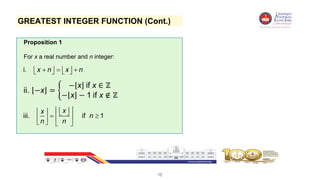







![20
DIVISORS AND MULTIPLES (Cont.)
Divisibility
1. To show 1S
Let kS.
8 | (52(1) + 7)
= 8 | 32 Since 32 = 8(4) (from def. of divisible)
Then, 1S .
2. To show (k+1) S , if kS
For n = 1,
Then, 8 | (52k + 7)
[To show 8 | (52(k+1) + 7) ]](https://image.slidesharecdn.com/chapter2lecturenotesdivisibility-240421032004-5e85f7d6/85/Chapter-2-Lecture-Notes_-Divisibility-pdf-20-320.jpg)





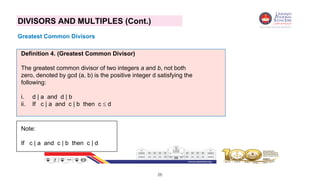

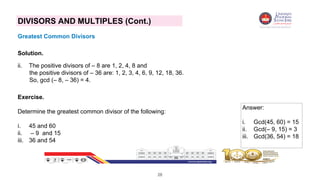













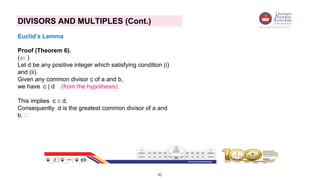








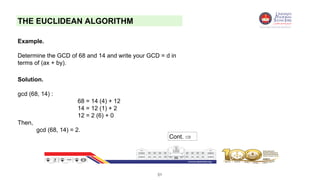
![52
THE EUCLIDEAN ALGORITHM
Solution. (Cont.)
Next to write d = (ax + by).
To find integers x and y that satisfy 68x + 14y = 2
2 = 14 – 12 (1)
= 14 – [68 – 14 (4)] 1
= – 68 + 14(5)
So, gcd (68, 14) = 2 = 68(–1) + 14(5), where
x = –1, y = 5.](https://image.slidesharecdn.com/chapter2lecturenotesdivisibility-240421032004-5e85f7d6/85/Chapter-2-Lecture-Notes_-Divisibility-pdf-52-320.jpg)

![54
THE EUCLIDEAN ALGORITHM
Solution. (Cont.)
Next to write d = (ax + by).
To find integers x and y that satisfy 42823x + 6409y = 17
17 = 2040 – 289 (7)
= 2040 – [4369 – 2040 (2)] 7
= 2040 (15) – 4369 (7)
= [6409 – 4369] 15 – 4369 (7)
= 6409 (15) – 4369 (22)
= 6409 (15) – [42823 – 6409 (6)] 22
= 6409 (147) – 42823 (22)
So, gcd (42823, 6409) = 17 = 42823 (–22) + 6409 (147) , where
x = –22, y = 147.](https://image.slidesharecdn.com/chapter2lecturenotesdivisibility-240421032004-5e85f7d6/85/Chapter-2-Lecture-Notes_-Divisibility-pdf-54-320.jpg)










![65
LINEAR DIOPHANTINE EQUATION
Solution. (Cont.)
Using "backtracking" to find x and y :
3 = 9 – 6
= 9 – [114 – 9 (12)]
= 9 (13) – 114
= [123 –114] 13 – 114
= 123 (13) – 114 (14)
= 123 (13) – [360 – 123 (2)] 14
= 123 (41) + 360 (–14)
Then,
99 = (3) (33) = 123 (1353) + 360 (–462)
Hence the particular solution: x0 = 1353, y0 = – 462.](https://image.slidesharecdn.com/chapter2lecturenotesdivisibility-240421032004-5e85f7d6/85/Chapter-2-Lecture-Notes_-Divisibility-pdf-65-320.jpg)


![68
LINEAR DIOPHANTINE EQUATION
Solution. (Cont.)
Using "backtracking" to find x and y :
4 = 12 – 8
= 12 – [20 – 12]
= 12 (2) – 20
= 2 [172 – 20(8) ] – 20
= 172 (2) + 20 (–17)
Then,
1000 = (4) (250) = 500 (172) + (–4250) (20)
Hence the particular solution: x0 = 500, y0 = – 4250.](https://image.slidesharecdn.com/chapter2lecturenotesdivisibility-240421032004-5e85f7d6/85/Chapter-2-Lecture-Notes_-Divisibility-pdf-68-320.jpg)

